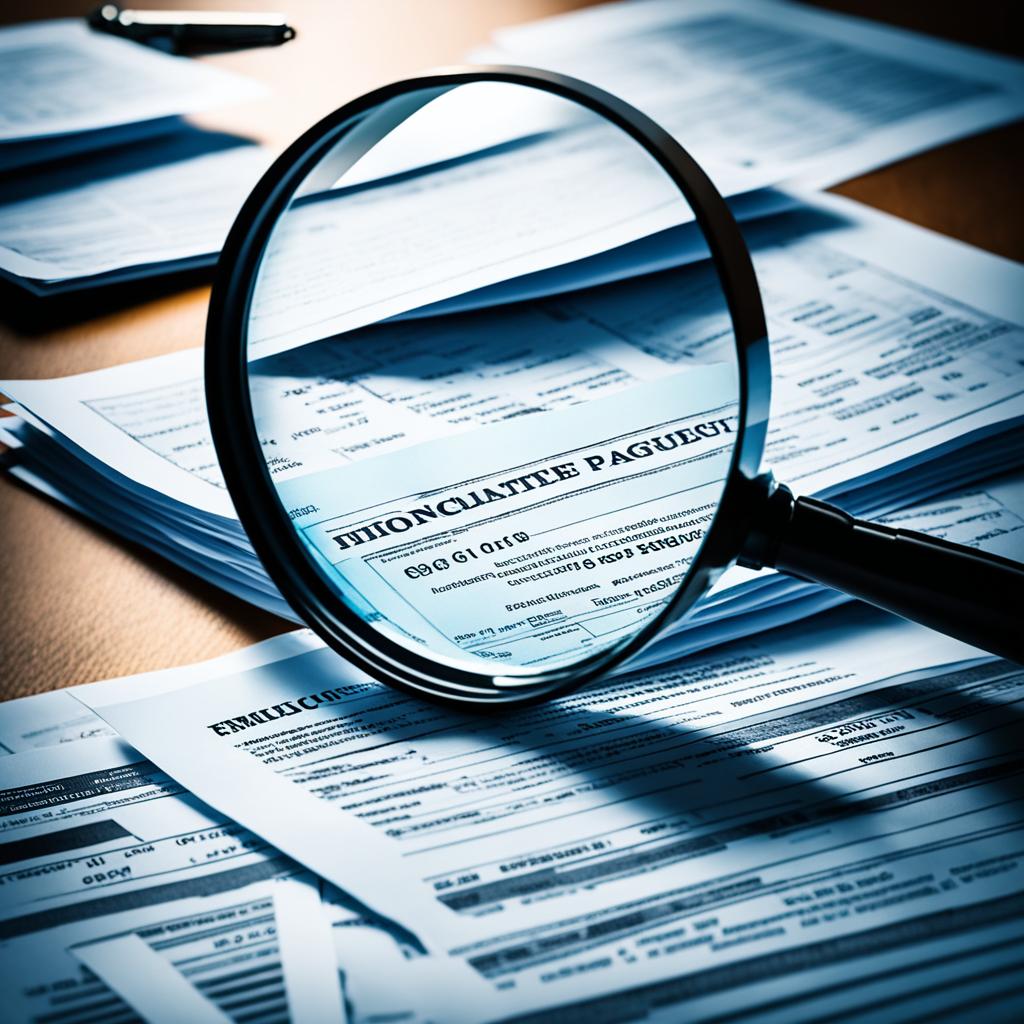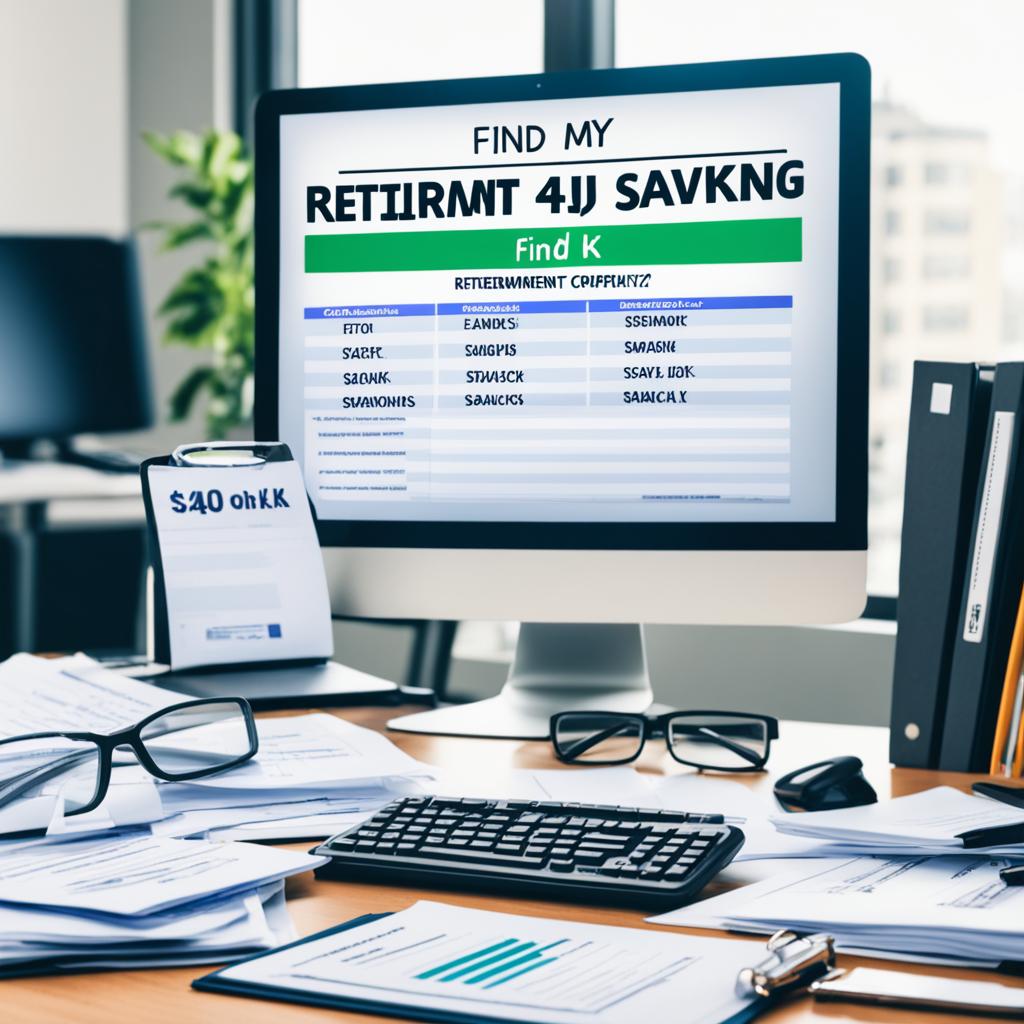Greetings! I’m here to guide you on a journey to find your lost 401(k) and take control of your retirement savings. In today’s dynamic job market, it’s easy for 401(k) accounts to slip through the cracks. But fear not, as I’ll provide you with step-by-step instructions on how to locate and access your forgotten funds.
Did you know that there are an estimated 29.2 million forgotten 401(k) accounts, collectively holding a whopping $1.65 trillion in assets? With job changes becoming more frequent and the “Great Resignation” phenomenon on the rise, it’s crucial to track down these lost accounts and maximize your retirement savings.
Key Takeaways:
- Follow these steps to find your lost 401(k) and secure your retirement savings.
- The average balance of forgotten 401(k) accounts is $55,400.
- By reclaiming your lost 401(k), you could potentially avoid losing up to $700,000 in retirement savings.
- Methods for finding your lost 401(k) include tracking down old plan statements, contacting former employers, searching through the Department of Labor’s website, and utilizing databases for unclaimed assets.
- Once you’ve located your lost 401(k), consider rolling it over into your current employer’s plan or an IRA based on your specific financial goals and circumstances.
The Importance of Finding Your Lost 401(k)
When it comes to securing your financial future, locating your lost 401(k) accounts plays a crucial role. These forgotten 401(k) accounts, also known as abandoned or unclaimed retirement funds, can have a significant impact on your retirement savings. With the average balance in these accounts being $55,400, reclaiming these assets can make a substantial difference in maximizing your retirement savings.
Over time, not finding and reclaiming your lost 401(k) can cost you up to $700,000 in potential retirement savings. This is money that could have been growing and working for you to ensure a comfortable and secure future.
“I never realized the impact of my forgotten 401(k) accounts until I finally tracked them down. It was like finding a treasure chest that had been left untouched for years. Reclaiming these funds allowed me to take control of my retirement savings and make the most of them.”
– Alice Thompson, a satisfied retiree
By taking the necessary steps to find your lost 401(k) accounts, you can ensure that every dollar is accounted for and put to work towards building your retirement nest egg.
Why Reclaiming Your Retirement Savings Matters
Reclaiming your lost 401(k) accounts offers several benefits:
- Maximize your retirement savings: By locating and reclaiming your forgotten accounts, you can ensure that all your retirement funds are working together to grow your savings. This can have a significant impact on the size of your nest egg when it comes time to retire.
- Take advantage of potential growth: Unclaimed retirement funds left in forgotten 401(k) accounts miss out on potential investment gains. By reclaiming these assets, you can put them to work and maximize their growth potential over time.
- Maintain financial security: Reclaiming your lost 401(k) ensures that you have a comprehensive view of your retirement savings. This knowledge allows you to make informed decisions about your financial future and maintain financial security in retirement.
Through the process of finding and reclaiming your lost 401(k) accounts, you can unlock the potential of your retirement savings and secure your financial future. Don’t let forgotten accounts hinder your retirement goals; take action and maximize your retirement savings today.
How to Find a Lost 401(k)
When it comes to finding a lost 401(k), there are several methods you can utilize. By combining these approaches, you can increase your chances of successfully locating your missing retirement savings and taking control of your financial future. Here are some effective methods to consider:
1. Track Down Old 401(k) Plan Statements
If you have held multiple jobs throughout your career, it’s possible that you have received old 401(k) plan statements in the past. These statements can serve as valuable clues in your search for a lost 401(k). Take the time to locate and review these statements, as they may contain crucial information such as the names of the employers and contact details for accessing your account.
2. Contact Former Employers
Another avenue to explore is reaching out to your former employers. Begin by contacting the Human Resources department or the department responsible for managing retirement accounts. Provide them with your personal information and inquire about any 401(k) participation during your employment. They should be able to assist you in locating and accessing your account.
3. Search Through the Department of Labor’s Website
The Department of Labor’s website can be a valuable resource in your search for a lost 401(k). By locating the company’s Form 5500, an annual report for employee benefit plans, you can find contact information for the plan’s administrator during your employment. Additionally, websites like FreeERISA can provide further information on lost accounts and assist you in your search.
4. Use Publicly Available Databases for Unclaimed Assets
If traditional methods have not yielded results, consider leveraging publicly available databases for unclaimed assets. Websites such as the National Registry of Unclaimed Retirement Benefits and the National Association of Unclaimed Property Administrators’ databases allow you to search for unclaimed 401(k) funds by entering your personal information. These resources can help you identify if any unclaimed retirement funds belong to you.
By exploring these methods and making use of the available resources, you can increase your chances of finding your lost 401(k) and reclaiming your retirement savings. Take the necessary steps to ensure that every dollar is accounted for and working towards your financial security.
Track Down Old 401(k) Plan Statements
When searching for a lost 401(k), one effective method is to locate old plan statements. These statements, whether received in the mail or electronically, can provide valuable information about your past employers and help you track down your account. By reviewing these statements, you can identify the companies you had 401(k) plans with and obtain the necessary contact information to access your account.
Going through your old 401(k) plan statements allows you to gather important details about your retirement savings. You may find information such as the dates of your employment, the contribution amounts, and the investment options available to you. This historical account history can be crucial in understanding your financial journey and making informed decisions about your retirement funds.
In addition to examining your own old plan statements, it can be beneficial to reach out to former co-workers who remain employed by your previous companies. They may have insights or contacts that can help you navigate the process of locating your lost 401(k). By leveraging their knowledge and experience, you can increase your chances of success in finding your account.
| Benefits of Tracking Down Old 401(k) Plan Statements | Considerations |
|---|---|
|
|
Contact Former Employers
If you do not have access to old plan statements, reaching out to your former employers directly can be a valuable step in finding your lost 401(k).
Contact the Human Resources department or the department responsible for handling retirement accounts to provide your personal information and inquire about any 401(k) participation during your employment.
They should be able to assist you in locating and accessing your account.
Important Information to Provide
When contacting your former employers, it is important to provide specific details to help them locate your lost 401(k) account. Here is the information you should include:
- Your full name as it appeared on your employment records
- Social Security number
- Date of birth
- Employment dates
- Any additional information that can help them identify your account
Reaching Out Effectively
When contacting your former employers, it’s essential to be polite and professional. Here are some tips for reaching out effectively:
- Double-check the contact information for the appropriate department or individual responsible for retirement accounts.
- Clearly state your purpose in the email or phone call, explaining that you are trying to locate and access your lost 401(k) account.
- Provide all necessary details and relevant information to help them assist you efficiently.
- Follow up if you don’t receive a response within a reasonable timeframe.
Remember, employers have a legal obligation to maintain retirement records, so they should be able to provide assistance in locating your account.
Find 401(k) Plan Information Through the Department of Labor
When searching for information about your old 401(k) plans, the Department of Labor’s website can be a valuable resource. One key document to locate is the company’s Form 5500, an annual report for employee benefit plans. This form provides essential details about the plan’s administrators during your employment, including their contact information.
In addition to the Department of Labor’s website, you can also utilize sites like FreeERISA to gather more information about potentially lost accounts. These platforms offer additional resources and tools to assist you in your search for missing 401(k) accounts.
If you are unsure how to navigate the Department of Labor’s website or other online resources, don’t hesitate to seek assistance. A financial advisor or retirement planning professional can provide guidance and help you make the most of these valuable resources.
Sample Table: Department of Labor Form 5500 Information
| Company | Plan Administrator | Contact Information |
|---|---|---|
| ABC Company | John Smith | (555) 123-4567 |
| XYZ Corporation | Jane Doe | (555) 987-6543 |
By utilizing resources such as the Department of Labor’s website and other online platforms, you can increase your chances of locating important information about your old 401(k) plans and the administrators in charge. Taking the time to gather this information is a critical step in reclaiming control over your retirement savings.
Search Databases for Unclaimed Assets
If traditional methods do not yield results, there are publicly available databases that can help you search for unclaimed assets, including your lost 401(k). These databases provide tools and resources for finding unclaimed retirement funds and other assets that may belong to you. Two prominent sources to consider are the National Registry of Unclaimed Retirement Benefits and the National Association of Unclaimed Property Administrators’ websites.
The National Registry of Unclaimed Retirement Benefits offers a comprehensive search tool specifically designed to locate unclaimed retirement funds. By entering your personal information into the database, you can uncover any unclaimed 401(k) funds that may have been overlooked. This resource streamlines the process of finding and retrieving lost retirement savings.
The National Association of Unclaimed Property Administrators’ website is another valuable resource for searching unclaimed assets, including lost 401(k) funds. This database consolidates unclaimed property records from various state government agencies, making it easier to locate any retirement funds that have become unclaimed or lost over time.
Both databases require you to enter your personal information to conduct a thorough search. It is important to exercise caution and ensure that you are using reputable sources when providing your sensitive information in online searches.
Remember, finding and reclaiming your lost 401(k) can have a significant impact on your overall retirement savings. Taking the time to explore these databases and search for unclaimed assets can be a crucial step in securing your financial future.

What to Do Once You’ve Found a Lost 401(k)
Now that you’ve successfully located your lost 401(k), it’s time to consider your next steps. Here are a few options for managing your old retirement account:
- Rollover into your current employer’s plan: If you’re still employed and your current company offers a 401(k) plan, you can opt to transfer your found 401(k) funds into your existing account. This consolidation can simplify your retirement savings management and provide access to potentially better investment options within your employer’s plan.
- Rollover into an Individual Retirement Account (IRA): Another option is to roll over your old 401(k) into an IRA. An IRA allows for greater flexibility and control over your investments, as you can choose from a wider range of financial products and providers. Opening an IRA is a straightforward process, and there are numerous online brokers available to assist you.
When deciding between these options, it’s essential to consider factors such as investment choices, fees, and your future financial goals. Consulting with a financial planner can provide valuable insights tailored to your specific circumstances, ensuring that you make the most informed decision.
Remember, the goal is to maximize your retirement savings and secure your financial future. Taking proactive steps to manage and invest your found 401(k) can help you achieve these objectives.
| Option | Benefits | Considerations |
|---|---|---|
| Rollover into current employer’s plan | – Consolidates retirement accounts – Simplifies management – Access to employer’s investment options |
– Limited investment options – Plan restrictions and fees – Potential loss of employer match |
| Rollover into an IRA | – Greater investment flexibility – Potential for more competitive fees – Control over investment choices |
– Requires active management – Potential for higher fees – Limited creditor protection |
By taking control of your found 401(k) and making smart investment decisions, you can put your retirement savings back on track and create a solid financial foundation for the future.
Roll Over the Old 401(k) Account Into Your Current Employer’s Plan
If you have found a lost 401(k) account and are currently employed, rolling it over into your current employer’s retirement plan can be a beneficial option. This allows you to consolidate your retirement accounts and simplify the management of your investments. However, before making this decision, it is crucial to assess the investment options available in your current plan and ensure they align with your financial goals.
By consolidating your old 401(k) into your current employer’s plan, you can take advantage of the benefits it offers. This includes the convenience of having all your retirement savings in one place, making it easier to track your progress and make informed investment decisions. Additionally, many employer-sponsored plans provide access to a diverse range of investment options, allowing you to tailor your portfolio to your risk tolerance and investment preferences.
To initiate the rollover process, you will need to contact your current employer’s HR department or retirement account administrator. They will guide you through the necessary steps and provide you with the required paperwork. It is important to carefully review and complete the paperwork, ensuring accuracy and compliance with any rollover rules and regulations.
Once the rollover is complete, your old 401(k) account will be transferred into your current employer’s plan. You will then have the opportunity to manage all your retirement savings within a single account and benefit from the potential growth of your investments over time.
Benefits of Rolling Over into Your Current Employer’s Plan
Consolidating your retirement accounts by rolling over your old 401(k) into your current employer’s plan can offer several advantages:
- Simplified management: Having all your retirement savings in one account makes it easier to monitor your investments and track your progress towards your financial goals.
- Access to a wider range of investment options: Many employer-sponsored plans offer a diverse selection of investment options, allowing you to create a well-balanced portfolio tailored to your needs.
- Potential cost savings: Some employer plans have lower fees and expenses compared to individual retirement accounts (IRAs) or other investment vehicles, potentially saving you money in the long run.
- Borrowing and withdrawal options: Certain employer plans allow for loans and hardship withdrawals, providing flexibility in times of financial need.
Before rolling over your old 401(k) into your current employer’s plan, it is advisable to assess the investment options, fees, and any additional features offered by both your old and new plans. Comparing the benefits and drawbacks of each option can help you make an informed decision that aligns with your long-term financial objectives.
| Pros | Cons |
|---|---|
|
|
Roll Over the Old 401(k) Account Into an IRA
When it comes to managing your old 401(k) account, rolling it over into an Individual Retirement Account (IRA) is often the preferred option. With an IRA, you gain access to a wider selection of investment options compared to most employer-sponsored plans. This allows for greater control and flexibility in managing your retirement funds, ensuring that you can tailor your investments to align with your financial goals and risk tolerance.
Opening an IRA account is a straightforward process that can be done through online brokers or financial institutions. These platforms provide step-by-step guidance to help you set up your account, making it easier than ever to transfer your retirement funds into an IRA. By consolidating your old 401(k) into an IRA, you can streamline your financial management and have a comprehensive view of your retirement savings.
Benefits of Rolling Over into an IRA:
- Diverse Investment Options: IRAs offer a wide range of investment choices, including stocks, bonds, mutual funds, and even alternative assets like real estate or precious metals. This variety allows you to create a diversified portfolio that suits your risk tolerance and investment preferences.
- Greater Control: Unlike employer-sponsored plans, IRAs give you more control over your investments. You can actively manage and make changes to your portfolio as needed, ensuring that your retirement funds are working towards your specific financial goals.
- Flexible Withdrawal Options: IRAs often provide more flexibility when it comes to withdrawals. Depending on the type of IRA you choose, you may have options for penalty-free withdrawals before retirement age for certain qualified expenses, such as education, healthcare, or buying a first home.
- Continued Tax Advantages: Just like a 401(k), contributions to a traditional IRA are tax-deductible, and your investments grow tax-deferred until you make withdrawals in retirement. Roth IRAs, on the other hand, offer tax-free growth and tax-free qualified withdrawals in retirement.
Before making any decisions, it’s crucial to consider your individual financial situation and consult with a financial advisor or tax professional. They can provide personalized guidance based on your retirement goals, current tax situation, and any other factors that may impact your decision.
Remember, managing your retirement funds is an important step in securing your financial future. By rolling over your old 401(k) into an IRA, you can take greater control over your investments and build a solid foundation for a comfortable retirement.

Comparison of 401(k) Rollover Options
| Factors | Roll Over Into Current Employer’s Plan | Roll Over Into an IRA |
|---|---|---|
| Investment Options | Limited to employer’s offerings | Wide range of investment choices |
| Control | Subject to employer’s plan rules | Greater control over investments |
| Withdrawal Flexibility | Subject to employer’s plan rules | More options for penalty-free withdrawals |
| Tax Advantages | Tax-deductible contributions; tax-deferred growth | Tax-deductible or tax-free contributions; tax-free growth and withdrawals (for Roth IRAs) |
The Importance of Consolidating Retirement Accounts
Consolidating your retirement accounts is a crucial step towards effective retirement planning. By consolidating your accounts, you can streamline your financial management, reduce administrative burdens, and gain a clearer understanding of your overall retirement savings.
Managing multiple retirement funds can be complicated and time-consuming. It’s easy to lose track of different accounts, investment strategies, and fees associated with each account. Consolidation simplifies the process by centralizing your retirement savings, making it easier to monitor and manage your funds.
The Benefits of Consolidating Retirement Accounts
- Streamlined Financial Management: When you consolidate your retirement accounts, you no longer have to keep track of multiple statements, login credentials, and investment strategies. Instead, you can focus on a single account and easily assess your overall financial health.
- Reduced Administrative Burdens: By consolidating your retirement accounts, you minimize paperwork and administrative tasks associated with managing multiple funds. This frees up your time and energy to focus on other important aspects of your life.
- Clearer Understanding of Retirement Savings: When your accounts are consolidated, you can clearly see the total amount of money you have saved for retirement. This knowledge allows you to set realistic financial goals and make informed decisions about your retirement planning.
Consolidating your retirement accounts also offers the opportunity to review your investment strategy. By assessing your current investments, you can ensure that they align with your financial goals and risk tolerance. It may be a good time to rebalance your portfolio or explore different investment options that better suit your needs.
Consolidating your retirement accounts is like tidying up your financial house. It brings order, simplicity, and a clearer path towards achieving your retirement goals.
If you have multiple 401(k) accounts from previous employers or other retirement accounts, consider consolidating them into a single account. This can be done through a rollover into your current employer’s retirement plan or by transferring funds into an individual retirement account (IRA).
Whichever method you choose, it’s essential to consult with a financial advisor to ensure you make the right decision based on your specific circumstances and retirement goals.
| Benefits of Consolidating Retirement Accounts | Considerations |
|---|---|
| Streamlined financial management | Ensure the new account has adequate investment options for your needs |
| Reduced administrative burden | Check for any potential fees or tax implications associated with consolidation |
| Clearer understanding of retirement savings | Review your investment strategy and make adjustments if necessary |
The Implications of Not Finding Your Lost 401(k)
Failing to locate and reclaim your lost 401(k) can have significant implications for your retirement savings. Over time, the unclaimed assets can accumulate and potentially cost you hundreds of thousands of dollars in potential growth. By taking the steps to find and manage your lost 401(k), you can ensure that you are maximizing your retirement savings potential.
| Implications of Not Finding Your Lost 401(k) | |
|---|---|
| 1. Lost Retirement Savings | Unclaimed 401(k) funds contribute to lost retirement savings. Without reclaiming these funds, you are missing out on the potential growth and compounding interest that could significantly boost your overall retirement nest egg. |
| 2. Missed Investment Opportunities | By not retrieving your lost 401(k), you are missing out on the opportunity to invest those funds in more lucrative assets. Over time, this can lead to a significant loss of potential returns that could have contributed to a more secure financial future. |
| 3. Reduced Retirement Income | Failed efforts to locate and claim your lost 401(k) can result in reduced retirement income. These unclaimed funds could have provided an additional source of income during your retirement years, ensuring a more comfortable and financially stable lifestyle. |
| 4. Incomplete Financial Picture | Not finding your lost 401(k) means you are left with an incomplete financial picture. Successfully reclaiming these retirement funds allows you to gain a comprehensive understanding of your overall financial situation and make better-informed decisions for your future. |
Remember, time is of the essence when it comes to locating your lost retirement funds. Taking action now to find and manage your lost 401(k) ensures that you can make the most of your hard-earned savings and secure a brighter financial future.
Now that you understand the impact of not reclaiming your retirement funds, it’s time to take action and find your lost 401(k). In the next section, I’ll guide you through the step-by-step process of locating your forgotten accounts and reclaiming your hard-earned savings.
The Future of Finding Lost 401(k)s
The future of finding lost 401(k)s is looking brighter thanks to the SECURE 2.0 Act. This legislation aims to improve Americans’ retirement savings and make it easier to locate and manage lost accounts. One significant provision of the act is the establishment of a lost-and-found database specifically for workplace retirement plans.
This database will serve as a centralized resource, providing individuals with a convenient way to locate and contact the administrators of their past retirement accounts. By streamlining the search process, this database will save time and effort for individuals looking to track down their lost 401(k)s.
Another important aspect of the SECURE 2.0 Act is the emphasis on account portability. The act includes measures to ensure that retirement accounts can follow workers when they change jobs or leave a company. This portability will make it easier for individuals to keep track of and manage their retirement savings throughout their careers.
This legislation marks a significant step forward in improving retirement savings for Americans. With the implementation of the lost-and-found database and the focus on account portability, the process of finding and managing lost 401(k)s will become more efficient and accessible for individuals in the future.
Conclusion
In conclusion, finding and managing your lost 401(k) accounts is crucial for securing your financial future and maximizing your retirement savings. With an estimated 29.2 million forgotten 401(k) accounts in the United States, totaling $1.65 trillion in assets, it’s essential to take control of your retirement funds.
By following the step-by-step guide provided in this article, you can track down your lost 401(k) and ensure that every dollar is working for you. Whether it’s through tracking down old plan statements, contacting former employers, using the Department of Labor’s resources, or searching for unclaimed assets, each method offers a potential avenue for locating your missing retirement savings.
To make the most of your newfound 401(k) account, consider consulting with a financial professional who can provide personalized advice and guidance tailored to your specific financial goals and circumstances. With the right strategies in place, you can secure your financial future and maximize your retirement savings for a comfortable and worry-free retirement.
FAQ
How can I find my lost 401(k)?
Why is it important to find my lost 401(k)?
How do I track down old 401(k) plan statements?
How can I contact my former employers to find my lost 401(k)?
Can the Department of Labor’s website help me find information about my old 401(k) plans?
What databases can I search for unclaimed retirement assets, including lost 401(k) funds?
What should I do once I’ve found a lost 401(k)?
How can I roll over the old 401(k) into my current employer’s retirement plan?
What are the benefits of rolling over the old 401(k) into an IRA?
Why is it important to consolidate retirement accounts?
What are the implications of not finding my lost 401(k)?
What is the SECURE 2.0 Act, and how does it affect finding lost 401(k)s?
How can I secure my financial future by finding my 401(k)?
Source Links
- https://www.aarp.org/retirement/planning-for-retirement/info-2022/find-forgotten-401k-and-other-money.html
- https://www.bankrate.com/retirement/how-to-find-lost-401k/
- https://www.nerdwallet.com/article/investing/how-to-find-an-old-401k-and-what-to-do-with-it
Money posts:
 26 Ways to Make Extra Money in 2024
26 Ways to Make Extra Money in 2024
 What are the 401(k) Contribution Limits for? (2024)
What are the 401(k) Contribution Limits for? (2024)
 Solo 401k Contribution Limits for 2024 and Beyond
Solo 401k Contribution Limits for 2024 and Beyond
 401K at 35: Are You on Track for Retirement? (2024)
401K at 35: Are You on Track for Retirement? (2024)
 Beagle 401K: Smart Retirement Planning Made Simple (2024)
Beagle 401K: Smart Retirement Planning Made Simple (2024)
 Will Millennials Be Able to Retire? (2024)
Will Millennials Be Able to Retire? (2024)
 Retirement Financial Advisor: Types + Responsibilities (2024)
Retirement Financial Advisor: Types + Responsibilities (2024)
 Blooom Review 2024: An Affordable Robo-Advisor
Blooom Review 2024: An Affordable Robo-Advisor

